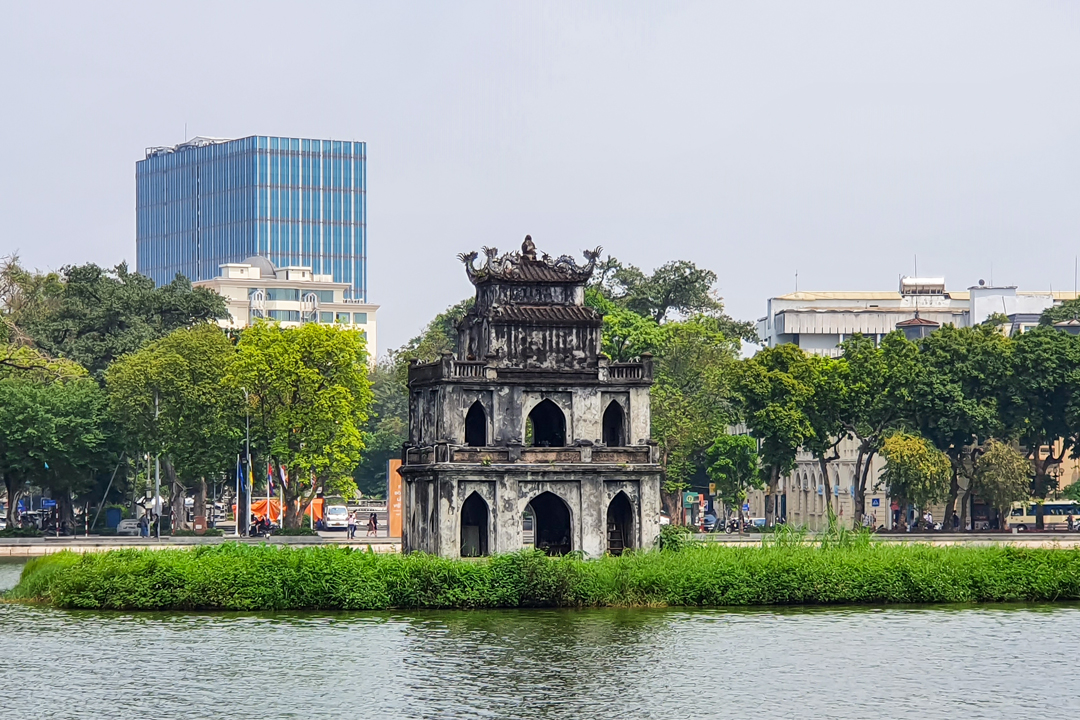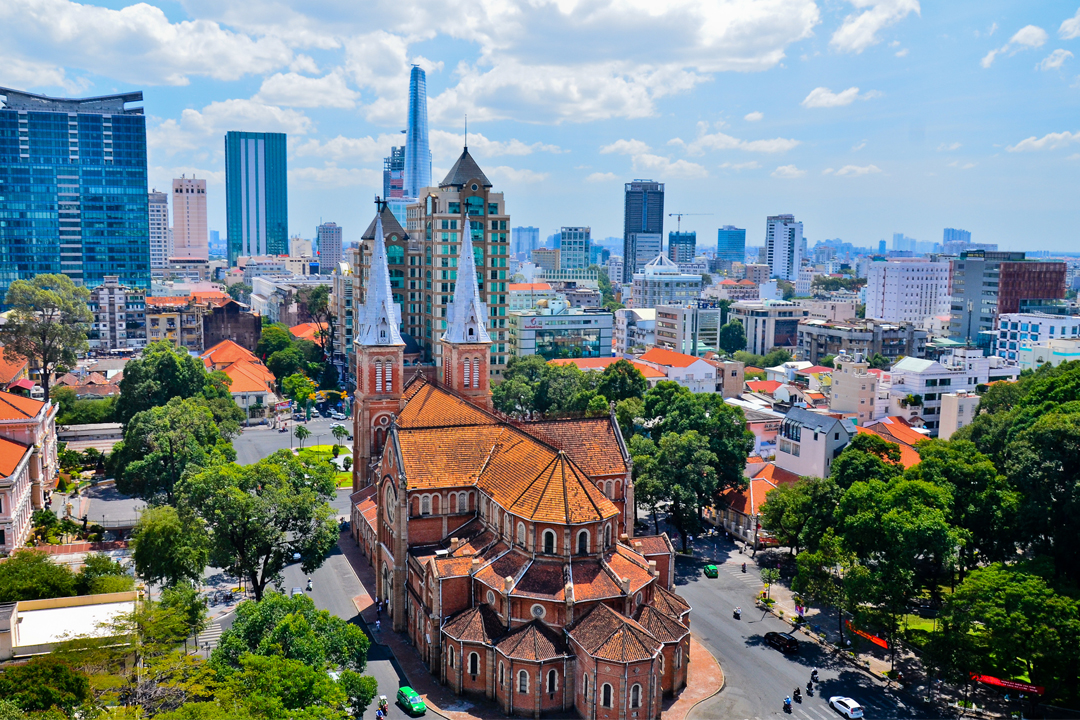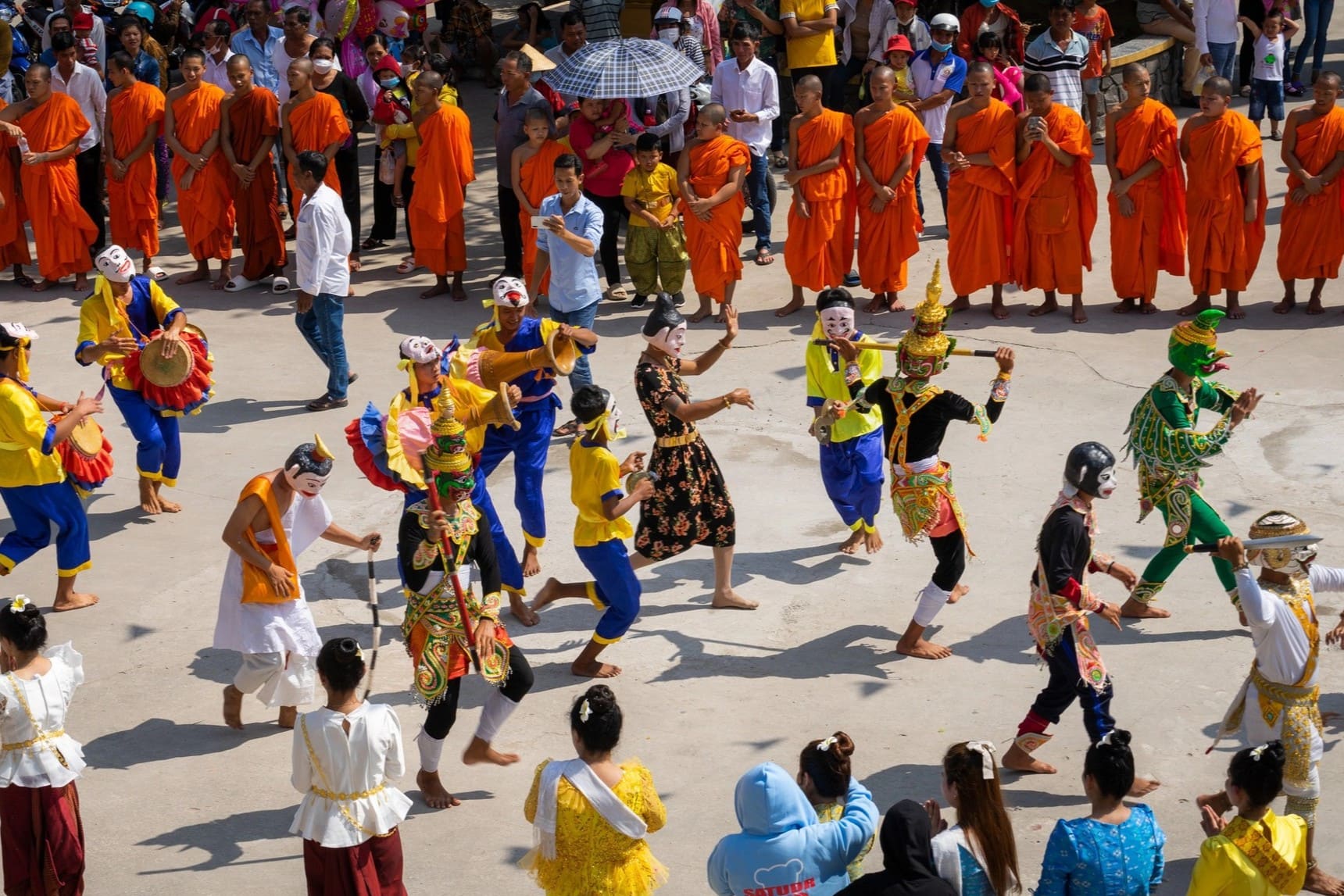Sep - 17 - 2025
Hanoi, the bustling capital of Vietnam, is a city where age-old traditions harmoniously coexist with modern dynamism, offering a captivating experience for every traveler. Amid the buzz of scooters and street vendors, Hanoi’s rich culture and history await discovery. If you seek adventure or quiet moments in gardens and pagodas, Hanoi offers something for everyone.
Diving into this article will unveil curated insights on the myriad things to do in Hanoi-revealing renowned landmarks and hidden gems that add depth to your journey. GTrip invites you to explore Hanoi througha mix of exciting and tranquil experiences, making your visit truly unforgettable.
1. Honor the legacy of President Ho Chi Minh at the Ho Chi Minh Mausoleum Complex
Ho Chi Minh Mausoleum Complex is a revered Hanoi landmark, attracting visitors paying tribute to Vietnam's revolutionary leader. Located in peaceful Ba Dinh Square, the marble mausoleum holds the embalmed body of Vietnam’s founding father, where independence was declared in 1945. White-uniformed guards stand watch, creating a solemn atmosphere as visitors silently pass through the chamber. The mausoleum, constructed between 1973 and 1975 with architectural influences from Lenin's Mausoleum in Moscow, reflects Vietnam's deep respect for Ho Chi Minh. It stands as a tribute to the man who devoted his life to the nation's independence.
You should plan their visit to coincide with the impressive Flag Ceremonies that take place daily at Ba Dinh Square. The Flag Raising Ceremony occurs at 6:00 AM during summer months (April 1 to October 31, 2025) and at 6:30 AM during winter (November 1 to March 31, 2026). The Flag Lowering Ceremony happens consistently at 9:00 PM year-round. Beyond the mausoleum itself, the complex includes several noteworthy attractions:
- Presidential Palace: The yellow colonial building where Ho Chi Minh worked but chose not to live
- Stilt House: The modest home where Ho Chi Minh resided from 1958 until he died in 1969
- One Pillar Pagoda: A unique architectural marvel rebuilt several times throughout history
- Ho Chi Minh Museum: A modern structure housing exhibits about his life and Vietnam's revolutionary struggle
Visitor tips:
- Dress respectfully with covered shoulders and knees
- Photography is prohibited inside the mausoleum
- The complex closes annually for approximately two months (typically October to November) when the body is sent to Russia for maintenance
- Morning visits are recommended to avoid both crowds and afternoon heat
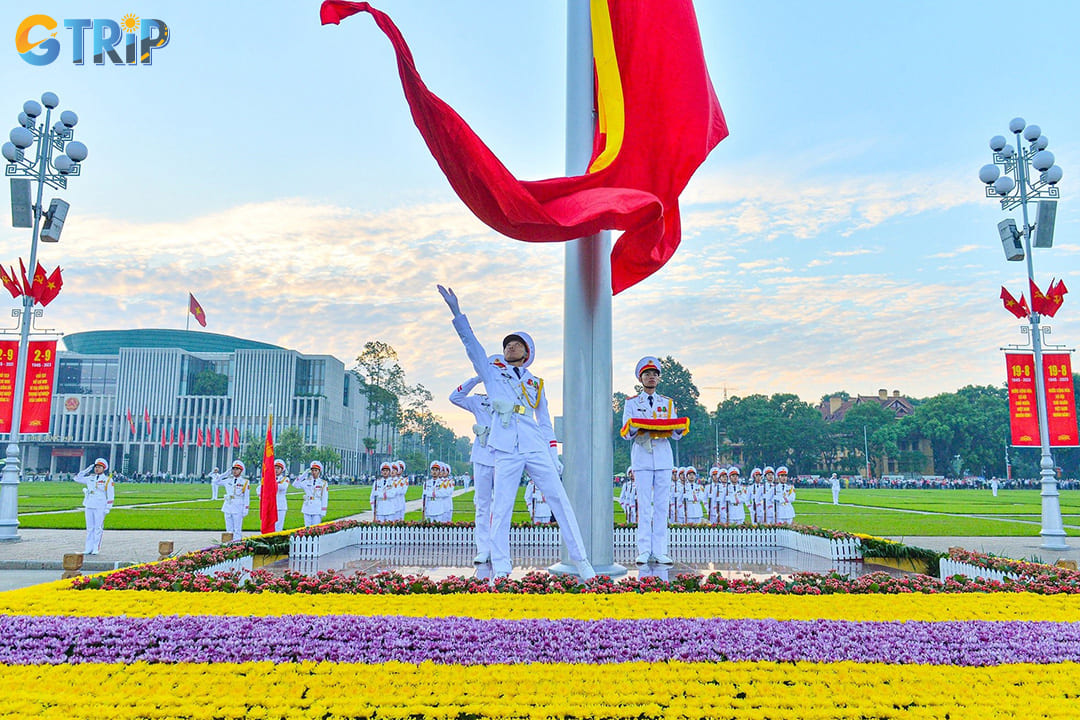
A solemn landmark in Ba Dinh Square, the Ho Chi Minh Mausoleum Complex honors Vietnam’s founding leader with historic sites and daily flag ceremonies
2. Climb the Hanoi Flag Tower in Ba Dinh for Hanoi's panoramic views
Standing as a proud symbol of Vietnam's resilience and independence, the Hanoi Flag Tower offers you one of the most spectacular vantage points in the city. Built during the Nguyen Dynasty in construction took place from 1805 to 1812 and was completed afterwards. This historic military structure has withstood the test of time, surviving numerous conflicts while continuing to fly the national flag high above Ba Dinh Square. The tower's strategic location within the Imperial Citadel of Thang Long complex makes it a perfect starting point for exploring central Hanoi's cultural landmarks.
The architectural marvel rises 33.4 meters in an elegant octagonal cylinder shape, with the flagpole extending its total height beyond 40 meters. As you ascend the 54 spiral steps (symbolising Vietnam's 54 ethnic groups), you'll notice the tower's unique design, narrowing as it climbs through three distinct floors of varying heights. The 39 fan-shaped openings provide natural airflow while casting graceful light patterns inside. Upon reaching the summit, you'll be rewarded with breathtaking panoramic views spanning from the ancient Imperial Citadel to the bustling Old Quarter. It offers a visual narrative of Hanoi's evolution from imperial capital to modern metropolis. The vibrant Vietnamese flag atop the tower is made from reinforced fabric to endure strong winds, a symbol of the nation's resilience.

An enduring symbol of resilience, the Hanoi Flag Tower offers sweeping city views and a striking gateway to explore the historic heart of the capital
3. Explore the Imperial Citadel of Thang Long UNESCO Site
Stepping into the Imperial Citadel of Thang Long is like walking through 13 centuries of Vietnamese history. This UNESCO World Heritage Site, dating back to the 7th century, stands as a testament to Vietnam's rich cultural heritage and dynastic past. The citadel served as the political center of Vietnam for centuries, housing emperors from multiple dynasties, including Ly, Tran, Mac, Le, and Nguyen. In 2022, the night tour "Decoding the Imperial Citadel of Thang Long" was launched, offering visitors a magical evening experience complete with traditional performances, refreshments, and illuminated archaeological sites. The Imperial Citadel features several magnificent structures that showcase Vietnam's imperial architecture:
- Doan Mon Gate: The main southern entrance to the citadel, featuring unique five-passage architecture that once dictated who could enter through which passage based on rank
- Kinh Thien Palace & Dragon Steps: Though the palace itself no longer exists, the ornate dragon-adorned stone steps remain, once leading to the emperor's throne
- Hau Lau (Rear Palace): Also known as the Princess' Palace, this multi-tiered structure combines Chinese and Vietnamese architectural elements, once housing royal concubines

Imperial Citadel of Thang Long offers a journey through 13 centuries of Vietnamese history, architecture, and imperial legacy
4. Visit the Temple of Literature, Vietnam's first university
Temple of Literature is established in 1070 during Emperor Ly Thanh Tong’s reign, originally honored Confucius and became Vietnam’s first national university in 1076. For nearly eight centuries, it nurtured the country’s brightest scholars and mandarins, symbolizing Vietnam’s deep respect for education and Confucian values.
The temple is divided into 5 courtyards, each with its own historical and cultural significance:
- First Courtyard (Great Middle Gate): Visitors enter through symbolic gates and walk along paths once reserved separately for kings, officials, and scholars.
- Second Courtyard (Pavilion of Constellation): Home to the iconic Khue Van Cac pavilion, a symbol of knowledge and Hanoi itself, featured on the 100,000 dong note.
- Third Courtyard (Well of Heavenly Clarity): Contains the rectangular well and stone steles on turtle backs, which record the names of scholars who passed royal exams from 1442 to 1779.
- Fourth Courtyard (Gate to Great Success): Houses altars dedicated to Confucius and his disciples, marking the temple’s sacred inner area.
- Fifth Courtyard (Imperial Academy): The site of Vietnam’s first university, including teaching halls and statues honoring notable scholars and kings.
A visit to the Temple of Literature after dark offers a unique and enchanting perspective. Under soft, warm lighting, the temple’s peaceful courtyards and ancient architecture take on a magical, almost spiritual atmosphere. The quiet ambiance invites reflection on Vietnam’s rich intellectual heritage.
Night tours often include detailed storytelling about the temple’s history and Confucian philosophy. You can also engage in cultural activities such as traditional calligraphy, listen to classical Vietnamese music, or participate in incense offerings at the altars. This nighttime experience provides a tranquil escape from the busy city life, making it an unforgettable highlight for travelers seeking both culture and serenity.

A serene symbol of Vietnam’s scholarly heritage, the Temple of Literature offers a journey through ancient Confucian traditions and the country’s first national university
5. Take in a water puppet performance at Thang Long Theatre
Water puppetry, a unique Vietnamese art form, dates back to the 11th century when villagers performed in flooded rice fields. Today, the Thang Long Water Puppet Theatre offers you the premier venue to experience this unique art form in Hanoi. Puppeteers wade behind a screen, guiding wooden puppets on water as musicians play traditional Vietnamese folk tunes with instruments like the monochord and bamboo xylophone. The Thang Long Theatre typically presents the following captivating shows:
- The legend of the restored sword: Depicts Emperor Le Loi returning his magical sword to the Golden Turtle in Hoan Kiem Lake, Hanoi's origin story
- Dragon dance: Features intricately carved dragon puppets dancing across the water's surface amid splashes and music
- Rice cultivation: Shows traditional farming methods from ploughing and planting to harvesting
- Buffalo boy playing the flute: A peaceful scene of rural Vietnamese life with water buffalo
- The fox and the rabbit: A humorous folk tale teaching moral lessons
- Fairy dance: Elegant puppets in flowing costumes perform graceful movements
- Fishing competition: Showcases village life with competitive fishermen displaying various techniques
- Four sacred animals (dragon, unicorn, turtle, phoenix): Depicts mythological creatures central to Vietnamese culture
- Lion dance: A festive performance representing good luck and prosperity
Shows run several times daily (typically 45 minutes), with tickets ranging from 100,000 to 200,000 VND. Arriving 30 minutes early is recommended to secure good seats for this quintessential Hanoi cultural experience.
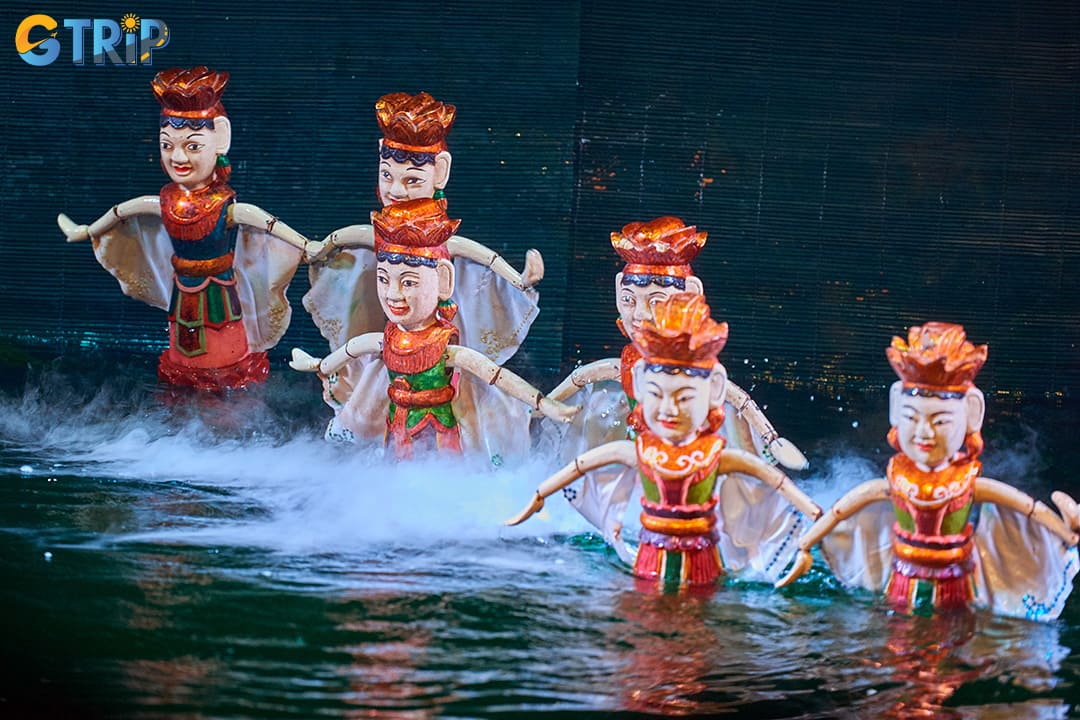
Thang Long Water Puppet Theatre brings Vietnam’s centuries-old water puppetry to life with live music, folk tales, and skillful performances on water
6. Hike to the sacred caves of the Perfume Pagoda Complex
Located about 60 kilometers southwest of Hanoi, the Perfume Pagoda (Huong Pagoda) is one of Vietnam’s most revered spiritual complexes and a breathtaking natural wonder. Nestled among towering limestone karsts and lush forests, this sacred site attracts thousands of pilgrims and visitors seeking blessings, peace, and enlightenment. Your journey to the Perfume Pagoda starts with a serene 30-minute boat ride along the Yen Stream. Gliding through calm waters, you're flanked by limestone peaks and lush rice fields, a serene gateway to this spiritual haven.
Must-visit sites within the complex:
- Thien Tru Pagoda (Heaven’s Kitchen): The largest temple in the complex, featuring intricate architecture and serving as a resting place before the ascent to the inner sanctuaries.
- Huong Tich Cave: Known as the “Number One Cave in the South”, this is the heart of the Perfume Pagoda complex. Accessible by foot or cable car, the cave houses the Inner Temple surrounded by stunning stalactites and stalagmites. Pilgrims come here to pray to Quan Am Buddha (Goddess of Mercy) for fertility, good fortune, and spiritual blessings.
- Giai Oan Pagoda: A temple dedicated to cleansing away earthly sorrows and karmic burdens, offering visitors a chance for spiritual renewal.
- Tuyet Son Pagoda: Perched atop a mountain peak, this temple offers panoramic views of the surrounding karst landscape, providing a breathtaking vantage point for reflection and appreciation of nature’s beauty.
- Trinh Temple: The first stop upon disembarking, this ancient temple is dedicated to the Mountain God and serves as a spiritual gateway to the complex. Visitors often stop here to offer prayers for a safe and auspicious journey.
The annual Perfume Pagoda Festival spans from the 6th day of the first lunar month to the 6th day of the third lunar month (roughly mid-February to mid-April/May). This vibrant festival draws millions of pilgrims who participate in traditional ceremonies, colorful processions, and cultural performances. It is the most lively and spiritually significant time to visit, embodying the rich cultural heritage and religious devotion of the Vietnamese people.
Tips for visitors:
- Dress modestly and respectfully when visiting temples and sacred sites.
- Wear comfortable footwear suitable for walking and hiking.
- Bring water and light snacks, especially if you plan to hike to the cave or mountaintop temples.
- Consider visiting on weekdays to avoid large crowds during weekends and peak festival days.
- Learn about local customs and rituals to enrich your experience and show respect.
The Perfume Pagoda is more than just a tourist attraction, it is a profound journey into Vietnam’s spiritual heart and natural splendor. If you seek inner peace, cultural insight, or simply the beauty of nature, a visit to this sacred site promises a memorable and meaningful experience.
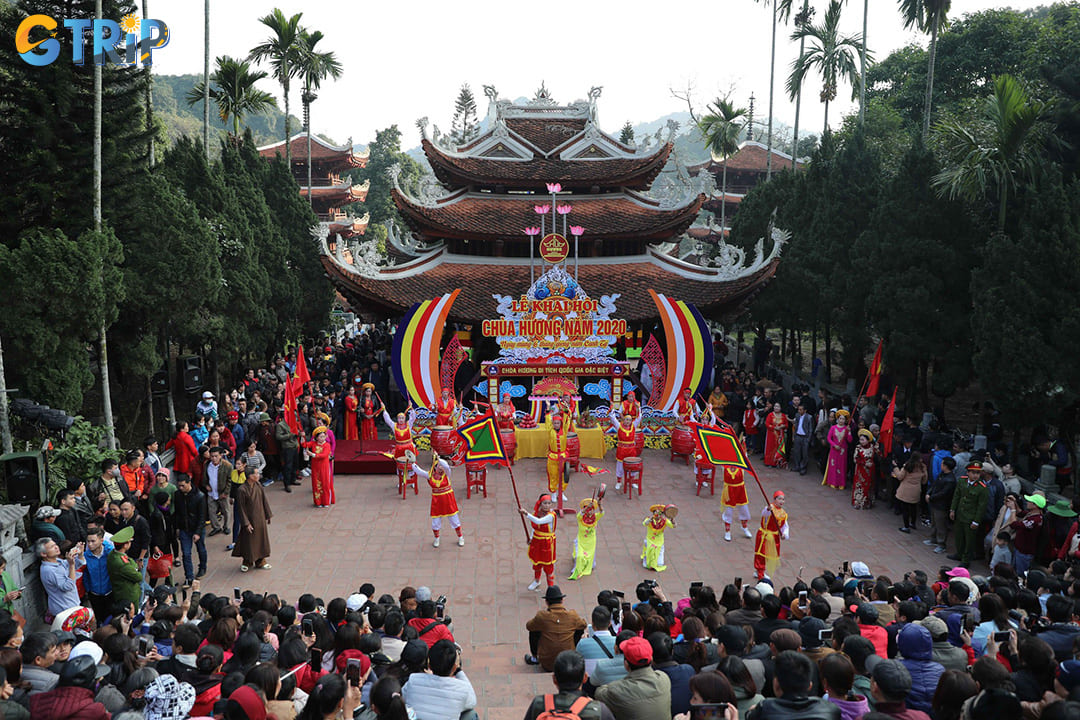
Perfume Pagoda is a sacred spiritual complex near Hanoi, offering a peaceful boat ride, cave temples, and breathtaking natural scenery
7. Marvel at Tran Quoc Pagoda on the shores of West Lake
Perched on a peninsula by West Lake, Tran Quoc Pagoda is Hanoi’s oldest Buddhist temple, with over 1,500 years of history. Originally built during the reign of Emperor Ly Nam De (544 - 548) on the banks of the Red River, the pagoda was later moved to its current site. This relocation in the 17th century helped protect it from the river’s erosion.
The pagoda’s iconic eleven-story red brick tower rises dramatically against Hanoi’s skyline, making it one of the city’s most photographed landmarks. Each level houses a serene statue of Amitabha Buddha, symbolizing peace and enlightenment. The surrounding complex features beautifully preserved prayer halls, intricate wood carvings, and ancient Bodhi trees. One of these trees was grown from a cutting of the original tree under which the Buddha attained enlightenment.
In 2019, Tran Quoc Pagoda received international acclaim when The Daily Mail named it among the world’s ten most beautiful Buddhist temples. It underscores its architectural grandeur and spiritual significance.
Approaching via the narrow causeway, you're greeted by incense smoke drifting through tiled rooftops, set against the calm waters of West Lake. Inside, the temple preserves priceless artifacts, including a stone stele from 1639 that chronicles its rich history.
The best times to visit are early morning, when monks perform their daily rituals, or at sunset, when golden light bathes the ancient structure in a warm, ethereal glow. For a peaceful, culturally rich escape from Hanoi’s bustle, Tran Quoc Pagoda offers a serene, historic sanctuary.
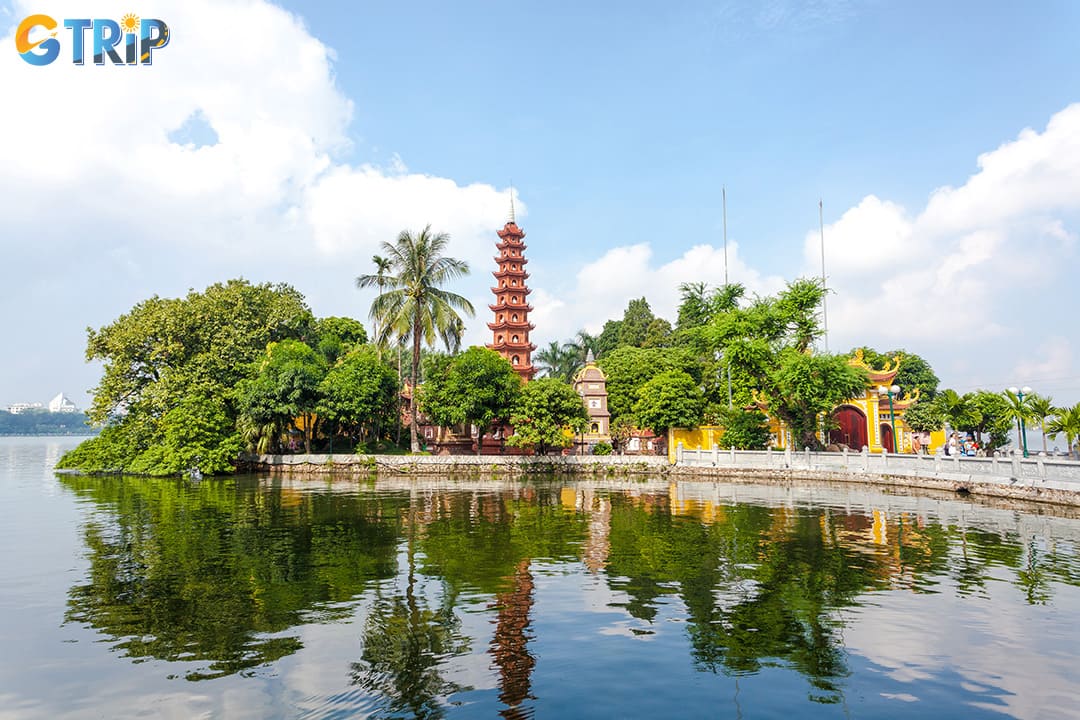
Tran Quoc Pagoda offers a serene lakeside retreat rich in history, spiritual symbolism, and striking architecture
8. Experience Bia Hoi Corner in Hanoi Old Quarter
Tucked in Hanoi's Old Quarter, Bia Hoi Corner offers one of the city's most authentic social experiences. This lively hub comes alive each evening as both locals and travelers gather on tiny plastic stools spilling onto the streets to enjoy Vietnam's unique "fresh beer" culture. Bia hoi, meaning "fresh beer", is a light, unpasteurized draft beer brewed daily without preservatives and typically containing just 3 - 4% alcohol. What makes this experience special is the refreshingly cheap beer and the vibrant atmosphere where cultural barriers dissolve amid laughter and conversation.
The experience extends beyond just drinking, offering a fascinating glimpse into Hanoi's social fabric. By evening, the corner buzzes with street life, as vendors serve local snacks like fermented pork and grilled corn that pair perfectly with the light beer. For the full experience, visit between 5 - 10 PM when the atmosphere is at its peak. Don’t be surprised if locals invite you to join their table or challenge you to a cheerful “mot, hai, ba, do!” (one, two, three, cheers!) toast. Though known for its evening buzz, some spots open by noon, offering a more laid-back take on Hanoi’s drinking culture.
Visitor tips for Bia Hoi Corner:
- Prices vary slightly between venues, but expect to pay 5,000 - 10,000 VND (approximately $0.20-0.40) per glass
- Best visiting hours: 5 PM to 10 PM daily, with peak atmosphere around 7 PM
- Combine with dinner at nearby street food stalls for a complete local experience
- Bring small denominations of Vietnamese dong, as most venues don't accept cards
- The freshest beer typically arrives in the late afternoon, so timing your visit accordingly ensures the best taste
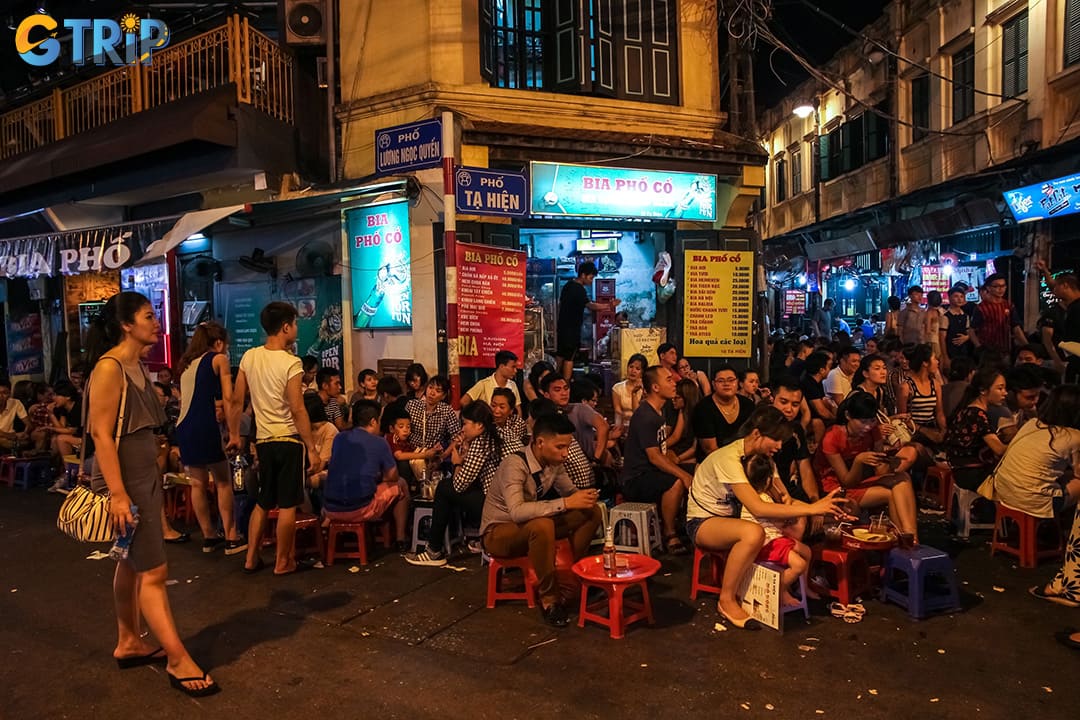
Bia Hoi Corner in Hanoi’s Old Quarter offers a lively, authentic taste of local beer culture, where fresh draft beer, street food
9. Go shopping at Dong Xuan Market at dawn
For early risers seeking an authentic glimpse into Hanoi's local life, Dong Xuan Market before sunrise offers an unfiltered cultural experience unlike any other in the city. Vietnam’s largest covered market comes alive by 4 - 5 AM, as locals arrive early to buy the freshest goods at wholesale prices. The ground floor transforms into a bustling hive of activity with merchants haggling over everything from fresh herbs and vegetables to just-caught fish still flipping in shallow basins. This isn't a sanitised tourist experience's raw, chaotic, and genuine, providing photographers and culture enthusiasts rare insights into everyday Vietnamese commerce.
Beyond the wholesale food section, dawn you can fuel their early morning adventure with authentic local cuisine from small food stalls tucked into the market's corners. Look for steaming bowls of pho or xoi (sticky rice with various toppings) prepared fresh for the market workers. By arriving during these twilight hours, you'll avoid the midday crowds and heat and witness the market in its most authentic state. While exploring the fragrant aisles, feel free to take photos, just ask permission and respect the busy vendors. For travelers seeking the true pulse of Hanoi, there's no better immersion than joining locals at Dong Xuan Market as the city awakens.

Dong Xuan Market at dawn offers early risers an unfiltered look into Hanoi’s daily life, where bustling wholesale trade and steaming street food reflect the city
10. Wander through the French Quarter's colonial boulevards
Step into Hanoi's French Quarter, where grand colonial buildings and tree-lined streets contrast the busy Old Quarter. Developed during French rule (1887 - 1954), this district features Parisian-style avenues and well-preserved colonial buildings. Between Hoan Kiem Lake and Ba Dinh, leafy streets and century-old trees offer a cool, peaceful retreat from Hanoi's summer heat.
The French Quarter serves as both a historical landmark and a modern hub for upscale experiences in Hanoi. Elegant boutiques line Trang Tien Street, while high-end restaurants and chic cafes occupy restored mansions throughout the neighborhood. You shouldn't miss the district's architectural highlights, including the magnificent Hanoi Opera House and the neo-Gothic St. Joseph's Cathedral with its twin bell towers. The impressive former Governor's Residence, now the Government Guest House, is also a standout. Visit early morning for tai chi under the trees or in the evening when colonial facades glow, evoking the charm of French Indochina.
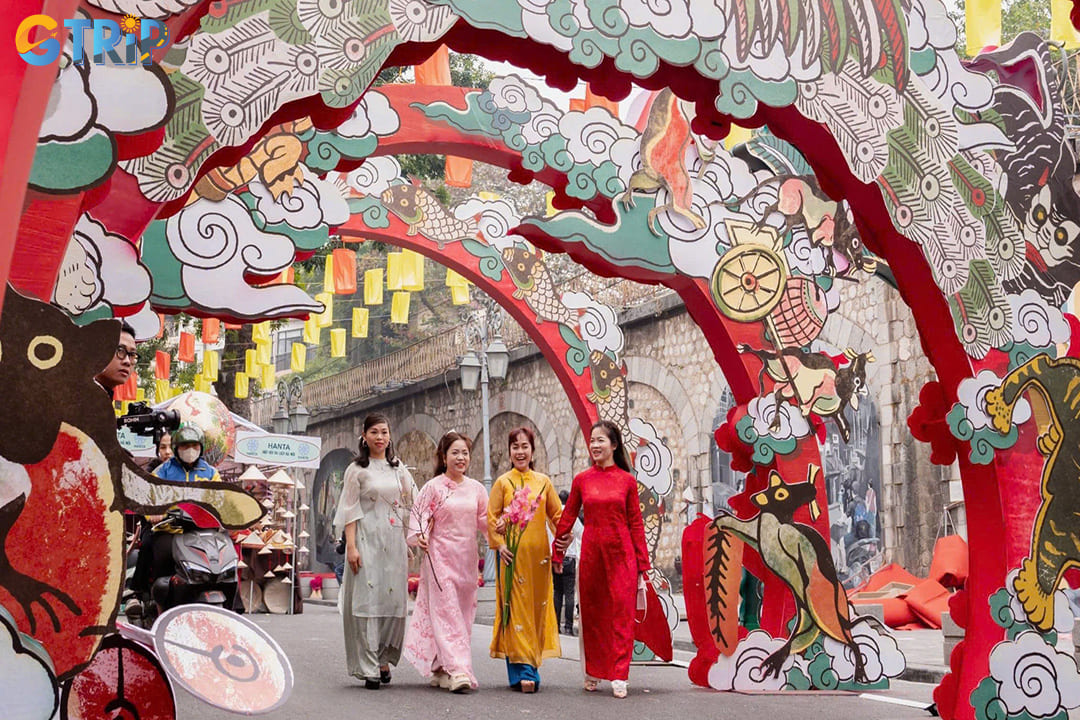
Hanoi's French Quarter blends colonial elegance with modern charm, offering leafy streets, grand architecture, and a tranquil escape from the city's bustle
11. Discover St. Joseph's Cathedral, a colonial-era landmark
Standing proudly in the bustling heart of Hanoi’s Old Quarter, St. Joseph’s Cathedral is a striking symbol of Vietnam’s French colonial heritage. Built in 1886, this Neo-Gothic church features 31-meter twin bell towers, stained glass windows, and ornate stone carvings inspired by Notre-Dame de Paris.
The cathedral’s weathered grey facade and Gothic arches contrast sharply with Hanoi’s surrounding architecture, making it a standout landmark. Inside, visitors are drawn into a serene and solemn atmosphere, where religious artifacts and the warm flicker of candlelight illuminate ornately decorated altars.
For an unforgettable experience, visit St. Joseph’s Cathedral on Christmas Eve. The cathedral and its surroundings come alive with festive spirit as thousands of locals and tourists gather for midnight mass. The square in front fills with glowing candles, vibrant decorations line the nearby streets, and the cathedral’s bells ring melodiously across the city. This annual celebration beautifully showcases the fusion of Western traditions and Vietnamese culture. After visiting the cathedral, explore nearby streets filled with cozy cafés and boutique shops for a relaxing break.
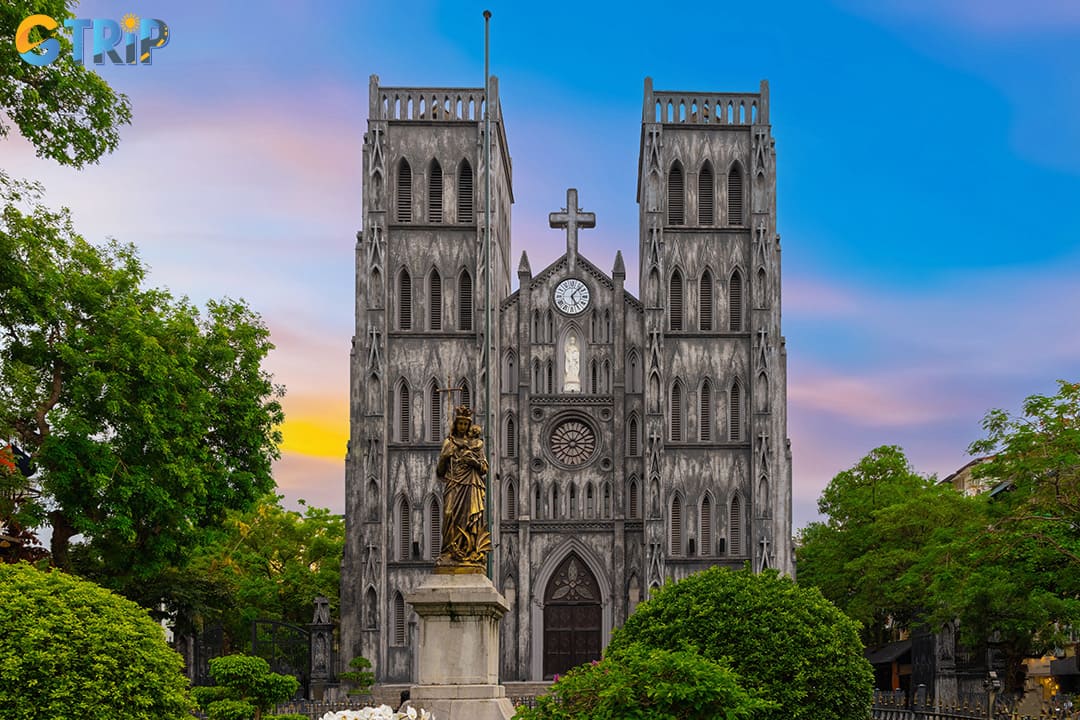
St. Joseph’s Cathedral is a stunning Neo-Gothic landmark in Hanoi’s Old Quarter, known for its towering twin spires, stained glass windows, and rich colonial history
12. Attend a classical performance at the Hanoi Opera House
Hanoi Opera House stands as a magnificent architectural gem in the heart of the city, built by French colonists between 1901 and 1911. This stunning neoclassical landmark features distinctively European design elements. It serves as Vietnam's premier performance venue, hosting everything from Vietnamese traditional music to international operas. The building is modeled after the Palais Garnier in Paris. It is worth admiring even before you step inside. Inside, you’ll experience remarkable acoustics and an opulent interior. Crystal chandeliers, marble staircases, and ornate balconies transport visitors to a different era.
Current performances at Hanoi Opera House:
- Vietnamese contemporary theatre: Acclaimed dramatic productions like "La don thu 72", "Vua Lear" (King Lear adaptation), and Tao Ngu's "Loi Vu" showcase Vietnam's evolving theatrical traditions
- Vietnamese musical showcases: Emotional concerts featuring compositions by Vietnamese masters like Phu Quang, or special tribute nights honoring legendary musician Trinh Cong Son
- Classical symphony performances: The Vietnam National Symphony Orchestra regularly performs works by Mozart, Beethoven, Haydn and other Western classical composers
- Cultural heritage shows: The vibrant "Quintessence of Tonkin" performance combines traditional music, water puppetry and folk tales in one spectacular show
- Ballet and contemporary dance: Both international troupes and the Vietnam National Opera & Ballet regularly present classical and modern productions
- Special diplomatic events: Cultural celebration concerts marking international relations, such as Romania-Vietnam friendship performances
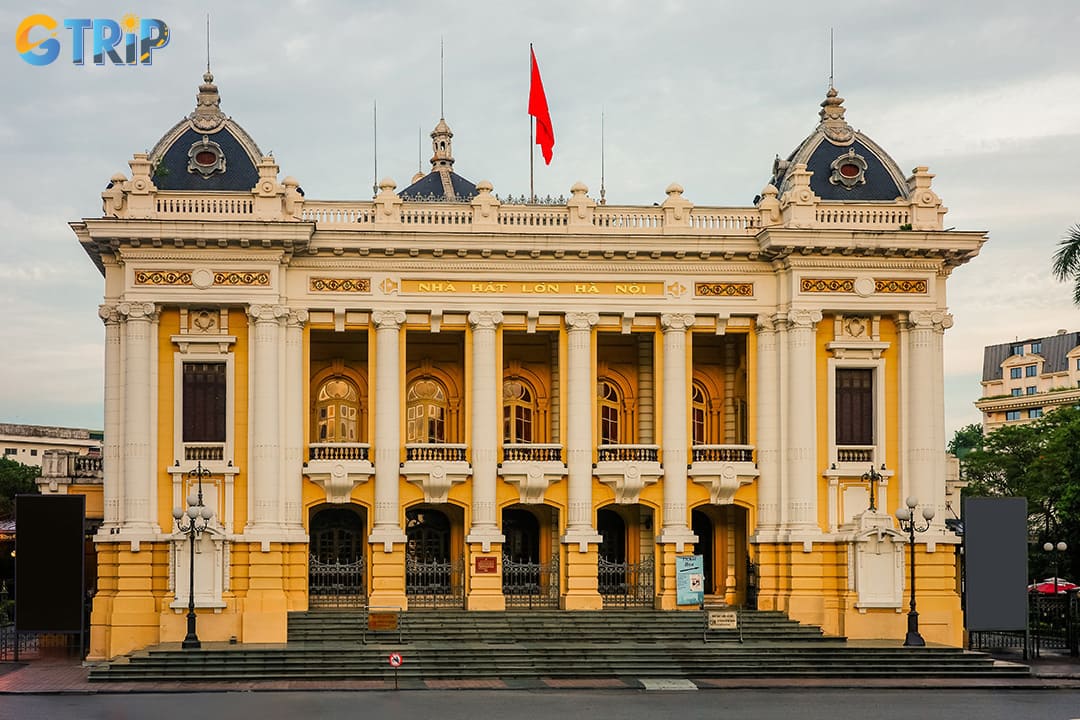
The Hanoi Opera House is a grand neoclassical landmark inspired by Paris’s Palais Garnier, offering world-class performances in a stunning colonial-era setting
13. Roam Hanoi Train Street as a local train rolls by
Tucked away in the heart of Hanoi lies one of the city's most extraordinary attractions, Train Street (Alley 224, Le Duan Street). This narrow alley, with houses inches from railway tracks, reveals daily Vietnamese life alongside active trains. Trains roar through this crowded neighborhood daily, forcing people to press against walls as they pass inches away. Laid in colonial times, the tracks now highlight Hanoi’s resilient, adaptable lifestyle and have become a unique tourist spot.
For an authentic experience, arrive at a Train Street café about 30 minutes before a train passes (usually around 3:00 PM and 7:00 PM). Order a traditional Vietnamese coffee or local beer at one of the small cafes lining the tracks, where you'll sit on tiny plastic stools positioned strategically for optimal viewing. When the train approaches, cafe owners will quickly usher you to safety while still maintaining prime viewing positions. The rumbling ground, blaring horn, and rush of wind as the train passes create an adrenaline-pumping experience unlike any other in Hanoi. While authorities occasionally restrict access due to safety concerns, residents who run these cafes usually welcome respectful visitors who purchase refreshments. This creates a win-win situation that supports the community while providing an unforgettable memory of Hanoi's unique urban landscape.
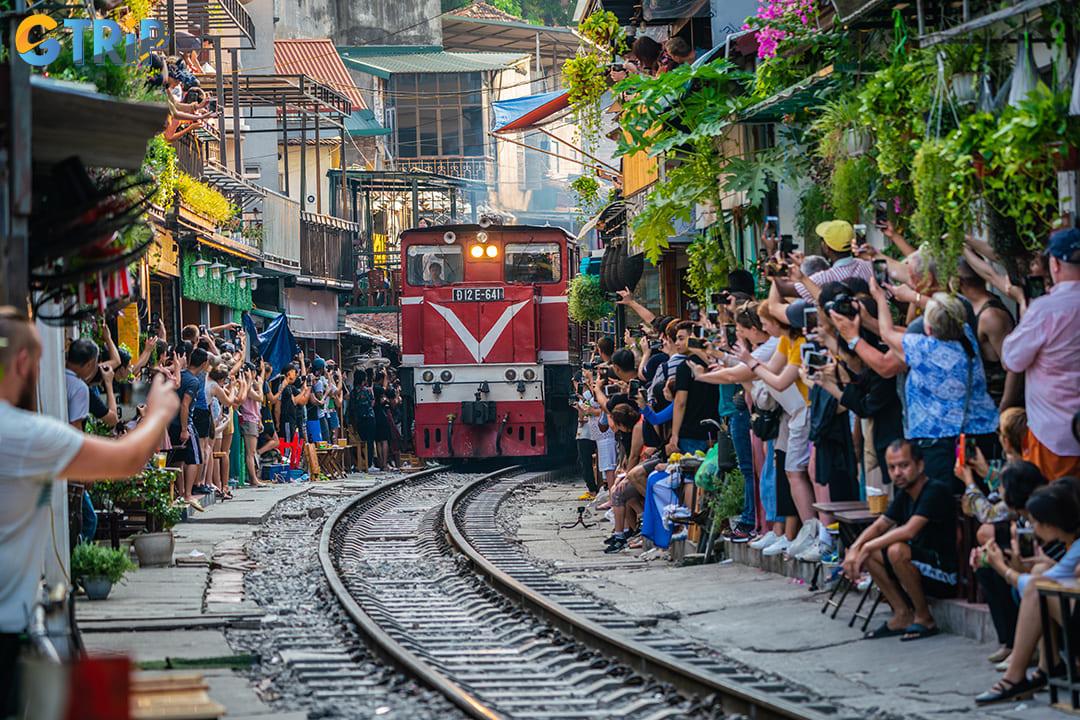
Train Street offers a thrilling, up-close glimpse of Hanoi life as trains pass inches from homes and cafés along narrow tracks in the city's heart
14. Learn Vietnamese cooking in a hands-on class
Hanoi offers a delicious gateway to Vietnamese culinary traditions through interactive cooking classes where visitors can master the art of creating authentic local dishes. These hands-on experiences typically include market tours to select fresh ingredients, detailed instruction from expert chefs, and the joy of enjoying your creations afterwards. Most classes suit all skill levels, from beginners to experienced cooks eager to master Vietnam's flavors and techniques.
Popular Vietnamese dishes taught in Hanoi cooking classes:
- Pho: Vietnam's iconic beef noodle soup with aromatic broth, rice noodles, and herbs
- Cha gio: Crispy fried spring rolls filled with minced pork, mushrooms, and vegetables
- Bun cha: Grilled pork served with rice noodles, herbs, and dipping sauce (Hanoi specialty)
- Banh xeo: Savory rice flour pancakes with pork, shrimp, and bean sprouts
- Goi cuon: Fresh summer rolls with shrimp, herbs, and rice vermicelli
- Canh chua: Sweet and sour soup with fish and tamarind
- Che: Sweet dessert soups with beans, fruits, and jellies
- Egg coffee: The famous Hanoi specialty drink with whipped egg yolks and coffee
Most cooking classes last 3-5 hours and include recipe cards to take home, ensuring you can recreate your favorite Vietnamese dishes long after your Hanoi adventure ends. Prices typically range from $25 to 65 per person, depending on class duration, dishes prepared, and whether market tours are included.

Hanoi cooking classes let you dive into Vietnamese cuisine through hands-on lessons, market tours, and delicious local dishes like pho, bun cha, and egg coffee
15. Browse artisan pottery at Bat Trang Ceramic Village
Just 13km southeast of Hanoi's bustling center lies Bat Trang Ceramic Village, a living testament to Vietnam's rich artistic heritage dating back to the 14th century. This ancient village blends traditional pottery with modern innovations, offering visitors authentic Vietnamese craftsmanship. As you wander through the village's narrow lanes, you'll encounter dozens of family-owned workshops where artisans shape, paint, and fire pottery. They create everything from delicate teacups and vases to elaborate decorative pieces using techniques passed down through generations.
The heart of any visit should include the Bat Trang Pottery Museum, which showcases the evolution of ceramic craftsmanship from ancient times to contemporary designs. The museum showcases key pieces illustrating the blend of Chinese, Japanese, and Vietnamese influences shaping Bat Trang’s unique style. After exploring the museum, you can try your hand at creating their ceramic masterpiece at one of the many workshops offering pottery-making experiences. The village market lets you buy high-quality ceramics directly from artisans at much better prices than Hanoi’s tourist shops. Consider visiting on weekdays to avoid crowds and experience a more intimate connection with the village's ancient ceramic traditions.

Bat Trang Ceramic Village is a centuries-old hub of Vietnamese pottery where you can watch artisans at work, visit a ceramics museum, and even try making your piece
16. Visit Duong Lam Ancient Village, traditional architecture and rich cultural heritage
About 50 km from Hanoi, Duong Lam Ancient Village is famed for its well-preserved architecture and rich cultural heritage. Known as the “ancient Vietnamese village of laterite stone”, Duong Lam retains much of its traditional charm. Its green-tiled streets, laterite stone walls, and houses built from this local material reflect the region’s unique architectural identity.
The village’s architecture is simple yet elegant, featuring red-tiled roofs and thick walls that help regulate indoor temperature during hot summers. Houses are traditionally arranged in the “inner courtyard - outer guest area” layout, often oriented southeast to maximize sunlight exposure. The village’s laterite stone gates feature intricate carvings and serve both decorative and spiritual roles, symbolizing protection and welcome.
Duong Lam features key landmarks like Mong Phu Communal House, Ngo Quyen Temple, Mia Pagoda, and centuries-old homes. The communal house, built in Vietnamese-Muong stilt style with intricate carvings, serves as both a worship site and cultural hub. It hosts festivals like Saint Giong and communal celebrations that preserve traditions and strengthen community bonds.
Beyond architecture, Duong Lam preserves rich traditional cultural values through its customs, rituals, and handicrafts such as basket weaving and traditional rice cake making. Year-round festivals enliven the village, strengthening community bonds and sustaining its vibrant cultural life.
Visiting Duong Lam Ancient Village offers travelers a chance to admire the tranquil and timeless beauty of a northern Vietnamese countryside. You can also immerse yourseft in the authentic lifestyle, culture, and soul of the Vietnamese people through its streets, homes, festivals, and stories passed down through generations.
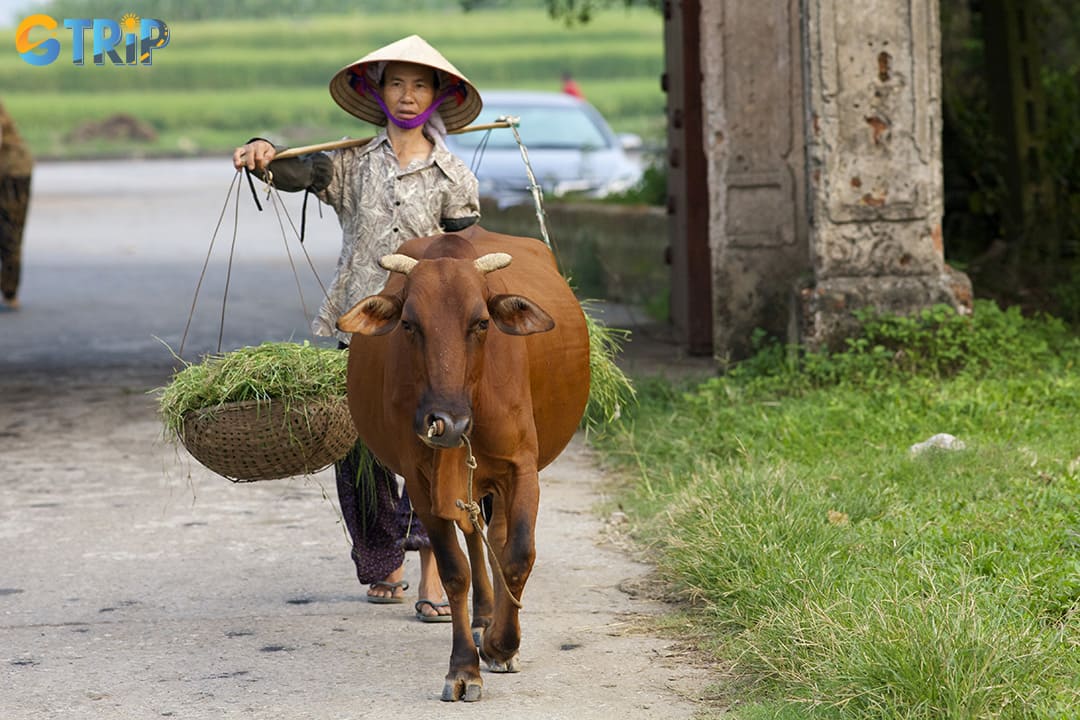
Duong Lam Ancient Village offers a rare glimpse into centuries-old Vietnamese rural life with its laterite stone houses, communal temples, and timeless traditions
17. Visit the museums in Hanoi
Hanoi boasts a rich and diverse system of museums that preserve the precious cultural and historical values of the Vietnamese nation. Spanning from ancient relics to contemporary art, the museums in Hanoi offer visitors an immersive experience of the nation’s cultural spirit and identity. Each museum has its distinct theme, creating a comprehensive picture of the country and its people throughout different historical periods:
- Vietnam Museum of Ethnology: Showcases the culture of 54 Vietnamese ethnic groups with authentic traditional houses and live handicraft demonstrations.
- National Museum of History: Introduces Vietnam’s history from prehistoric times to the modern era with many valuable artifacts and important historical documents.
- Ho Chi Minh Museum: Exhibits the life and career of President Ho Chi Minh through thousands of artifacts, images, and documents.
- Vietnam Fine Arts Museum: Displays artworks from ancient to contemporary times, including paintings, sculptures, and traditional ceramics.
- Vietnam Women’s Museum: Honors the role of Vietnamese women throughout history with traditional costumes, jewelry, and life stories.
- Vietnam Military History Museum: Features weapons, military uniforms, and reenactments of important historical battles of the Vietnamese nation.
Visiting these museums offers a valuable opportunity to delve deeper into Vietnam’s rich heritage, understand its complex history, and appreciate the resilience and creativity of its people. If you are interested in culture, history, art, or social stories, Hanoi’s museums provide meaningful and inspiring experiences that enrich any trip to the capital. You shouldn’t miss the chance to explore these cultural treasures and gain a fuller appreciation of Vietnam’s unique identity.
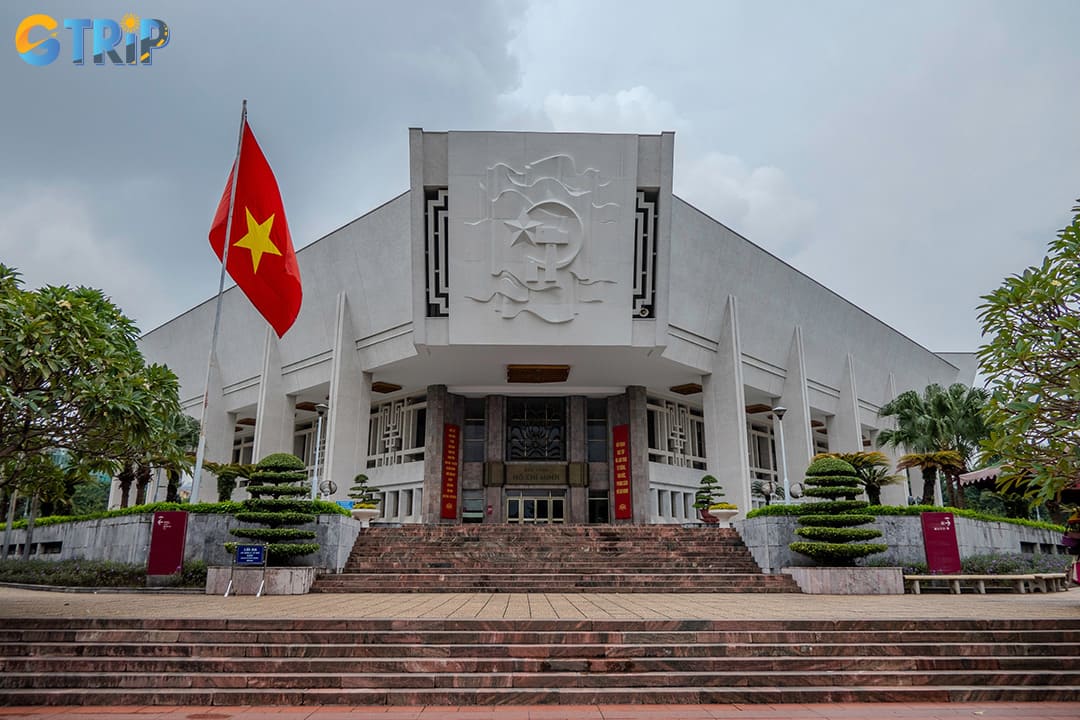
Hanoi’s museums offer a rich journey through Vietnam’s history, culture, and art, from ancient relics to ethnic heritage and revolutionary milestones
18. Participate night tour of Hoa Lo Prison and learn its history
Step into the shadows of Vietnam's complex past at Hoa Lo Prison, famously nicknamed the "Hanoi Hilton" by American prisoners of war during the Vietnam War. Originally constructed by the French colonial administration between 1896 and 1901, Hoa Lo meaning "Fiery Furnace" or "Hell’s Hole". It served as a central prison (Maison Centrale), primarily for Vietnamese political prisoners resisting colonial rule.
Located at 1 Hoa Lo Street in Hanoi’s Hoan Kiem District, the prison once housed thousands under harsh conditions far exceeding its original capacity. It later became infamous for detaining American pilots and POWs during the Vietnam War, including notable figures such as Senator John McCain.
Today, a portion of the original prison complex remains as a museum dedicated to preserving this poignant history. Tourists can explore exhibits detailing the brutal realities faced by inmates under French colonial rule and during the American conflict, including artifacts, photographs, and reconstructed prison cells.
For a uniquely immersive experience, the “Sacred Night - Glorious Vietnamese Spirit” evening tour offers a dramatic retelling of Hoa Lo’s history. Held on Fridays, Saturdays, and Sundays at 7:00 PM (subject to seasonal scheduling), this 90-minute guided tour uses atmospheric lighting, sound effects, and theatrical performances. It vividly recreates prisoners’ daily lives, interrogation scenes, and daring escape attempts.
Guides lead visitors through evocative scenes that highlight the resilience and indomitable spirit of Vietnamese revolutionaries and American POWs alike. The tour culminates in a moving tribute to human endurance in the face of oppression.
Hoa Lo Prison offers a sobering yet essential window into Vietnam’s turbulent history. It provides visitors with a deeper understanding of the sacrifices and resilience that shaped the nation. The night tour, in particular, transforms this historical site into a living narrative, delivering an emotional and educational experience that lingers long after you leave.
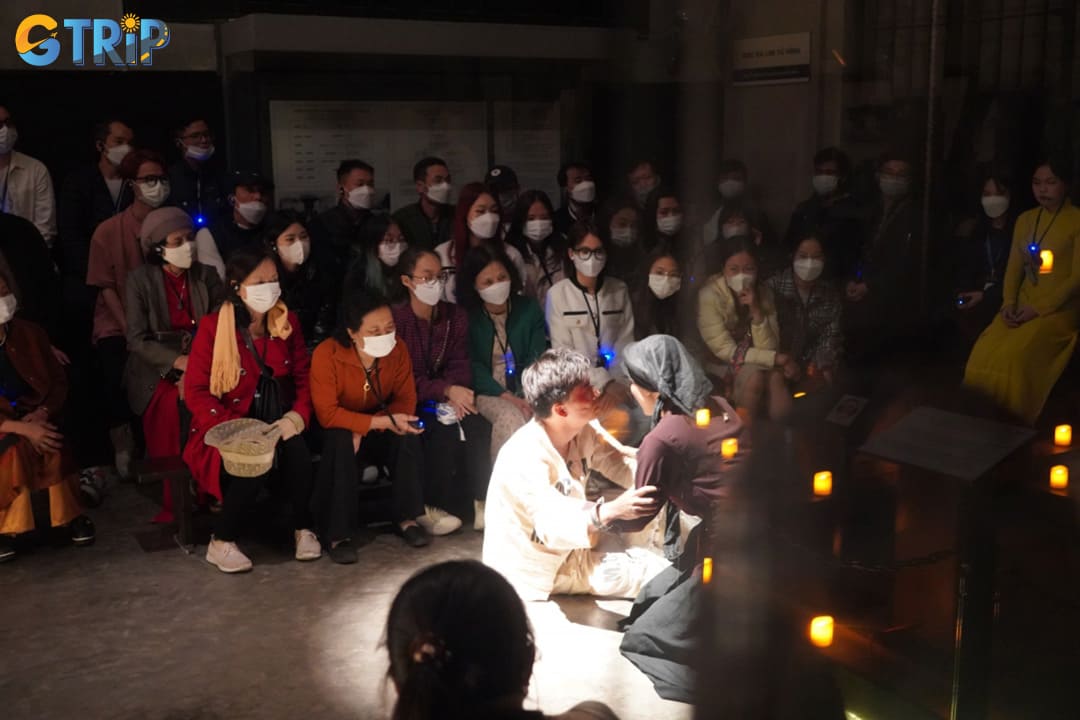
Relive Vietnam’s past at Hoa Lo Prison, where the immersive night tour uses light, sound, and theater to vividly portray stories of resilience and sacrifice
19. Sip cocktails at a rooftop bar overlooking Hoan Kiem Lake
After a day of exploring Hanoi's bustling streets and historic sites, elevate your evening with a visit to one of the city's sophisticated rooftop bars overlooking Hoan Kiem Lake. As the sun sets and the city lights begin to twinkle, these elevated establishments offer a magical vantage point to admire Hanoi's beating heart from above. Hoan Kiem Lake’s sparkling waters and glowing historic and modern buildings set the perfect scene for an unforgettable evening cocktail.
Top rooftop venues with lake views:
- The Twilight Sky Bar: Located on the 11th floor with panoramic views and signature Vietnamese-inspired cocktails
- Skyline Hanoi: Famous for its infinity edge design and extensive wine selection
- Summit Lounge: Offers 360° views and craft cocktails using local ingredients
- Terraco Sky Bar: Features bamboo and rattan decor with traditional Vietnamese touches
- The Rooftop: Known for its laid-back atmosphere and reasonably priced drinks
For the ultimate experience, time your visit to catch the sunset when the lake transforms from a daytime oasis to a nighttime jewel. The Huc Bridge stands out beautifully against the darkening sky. Many venues offer happy hour specials during these prime viewing hours, making this luxurious experience accessible to travelers on various budgets.

Overlooking the shimmering Hoan Kiem Lake from above, Hanoi's rooftop bars offer an enchanting evening with cocktails and a stunning sunset
20. Savor traditional egg coffee at a hidden cafe
Egg coffee is a Hanoi delicacy that perfectly embodies the city's innovative culinary spirit. This distinctive beverage features a creamy, custard-like topping made from whipped egg yolks, sugar, and condensed milk, floating atop a strong Vietnamese coffee base. The result is a decadent, dessert-like drink that offers a perfect balance of bitter coffee and sweet, velvety egg cream. While you can join a Hanoi City Tour to try coffee & other cuisine with expert guidance, seeking out these hidden cafes on your own delivers an authentic experience.
Here are three iconic spots in Hanoi where you can enjoy the finest egg coffee:
- Cafe Giang (39 Nguyen Huu Huan): The birthplace of egg coffee, founded in 1946 by Mr. Nguyen Van Giang, who created this drink when milk was scarce. The original recipe remains a closely guarded family secret, and the cafe's narrow entrance and modest interior lead to a charming retro space where you'll find the richest, most authentic egg coffee in Hanoi.
- Hanoi Egg Coffee (13 Lan Ong): A quieter alternative tucked away down a small alley, this cafe offers a more relaxed atmosphere away from tourist crowds. Their egg coffee features a particularly thick, meringue-like topping and comes served in a hot water bath to maintain the perfect temperature while you savor each sip.
- Loading T Cafe (8 Chan Cam): Housed in a beautiful French colonial building, this stylish cafe balances traditional recipes with contemporary design. Their egg coffee preparation includes a touch of cinnamon and cocoa powder sprinkled on top, creating a subtly spiced variation of the classic recipe.

Rich, creamy, and uniquely Hanoi, egg coffee blends bold Vietnamese brew with sweet whipped egg yolk for an unforgettable local treat
21. Relax and unwind at Hanoi spas
Hanoi offers a diverse range of spas and wellness centers, from traditional Vietnamese spas featuring herbal steam baths, medicinal massages, and acupressure. You’ll also find modern international-style spas in Hanoi that cater to all relaxation and beauty needs. Enjoy body massages, natural facial treatments, herbal detox baths, and traditional therapies that boost energy and health.
Well-known spas in Hanoi such as La Siesta Spa, Sen Spa, L’Apothiquaire Spa, and Anam QT Spa are renowned for their high-quality services. They also offer peaceful, green environments with harmonious designs that promote deep relaxation. Service packages vary widely in price, making them accessible to both budget travelers and those seeking luxury. These spas are perfect for recharging after busy days exploring the vibrant capital.

Unwind in Hanoi’s top spas, where traditional Vietnamese healing meets modern wellness in serene, rejuvenating settings
22. Nail care at salons in Hanoi
Nail services in Hanoi are highly regarded for their quality and creativity, while offering very reasonable prices compared to many other countries. The city has numerous nail salons, from small, friendly street shops to elegant, modern beauty centers. Popular brands such as The Nail Bar, Miu Nail & Spa, Lala Nail Salon, and Nail Story are trusted choices for both local and international customers.
Technicians here are skilled in performing a wide variety of nail styles, from simple and elegant designs to intricate, artistic nail art with unique patterns and personal flair. Services include nail trimming, long-lasting gel polish, creative nail art, professional pedicures, and specialized nail care treatments. Nail care in Hanoi is safe, high-quality, and significantly more affordable than in Western countries, making it a great budget-friendly beauty option.

Pamper yourself in Hanoi with stylish, high-quality nail services that blend creativity, professionalism, and unbeatable value
23. Take a Hop on Hop off bus tour to explore Hanoi
The Hop on Hop off bus tour is a convenient and flexible way to discover Hanoi’s main attractions at your own pace. With a 4-hour ticket, you can hop on and off at any of the 15 stops along the route, which covers over 20 famous landmarks such as Hoan Kiem Lake, Ho Chi Minh Mausoleum, Temple of Literature, Hoa Lo Prison, Tran Quoc Pagoda, and Imperial Citadel of Thang Long. The buses operate daily from early morning until late afternoon, with departures every 30 minutes. On weekdays, they depart from key points like Dong Kinh Nghia Thuc Square, and on weekends from Hanoi Opera House.
The open-top double-decker buses provide comfortable seating and panoramic views, perfect for sightseeing and taking photos. An audio guide in multiple languages, including English and Vietnamese, offers detailed commentary about the history and culture of each site. This self-guided tour allows travelers to customize their itinerary, spending more time at places of interest and easily returning to the bus when ready to move on.
For those wanting to explore Hanoi by night, there is also a 60-minute Hop on Hop off night tour available, offering a unique perspective of the city’s illuminated landmarks. Overall, the Hop on Hop off bus tour is ideal for first-time visitors or anyone looking for a hassle-free way to experience Hanoi’s rich heritage and vibrant city life.
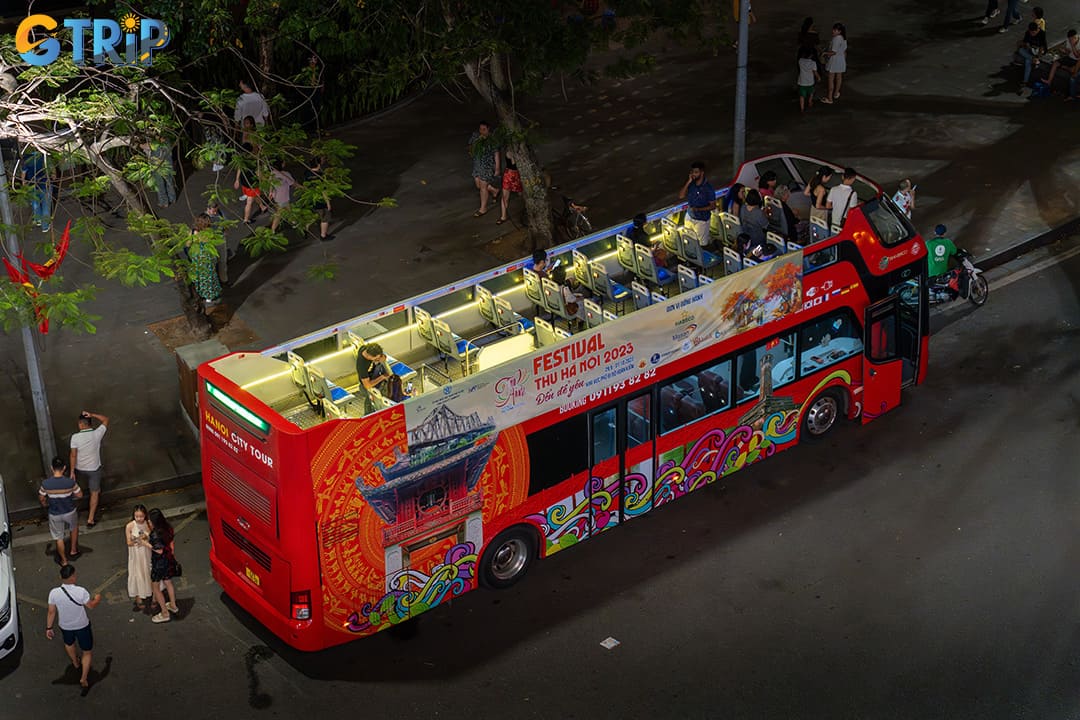
Hop-on Hop-off bus tour in Hanoi offering panoramic views, multilingual audio guides, and easy access to over 20 major attractions
24. Enjoy the fresh air at Hoan Kiem Lake in the early morning
Hoan Kiem Lake is especially charming in the early morning when the air is fresh, quiet, and cool. From around 5:30 to 7:00 AM, the area around the lake becomes a natural outdoor gym for locals, featuring a variety of activities such as Tai Chi, dancing, aerobics, yoga, and jogging. You can join in these gentle exercises or simply take a leisurely walk around the lake, enjoying the peaceful scenery with the water reflecting the morning light.
Afterwards, stop by one of the lakeside cafes to savor a traditional Vietnamese drip coffee while watching the daily life of Hanoi’s residents begin. You shouldn’t forget to visit iconic landmarks around the lake, such as the Turtle Tower, The Huc Bridge, and Ngoc Son Temple, all important historical and cultural highlights. A morning at Hoan Kiem Lake refreshes your body and mind and offers an authentic Hanoi experience to start your day full of energy.
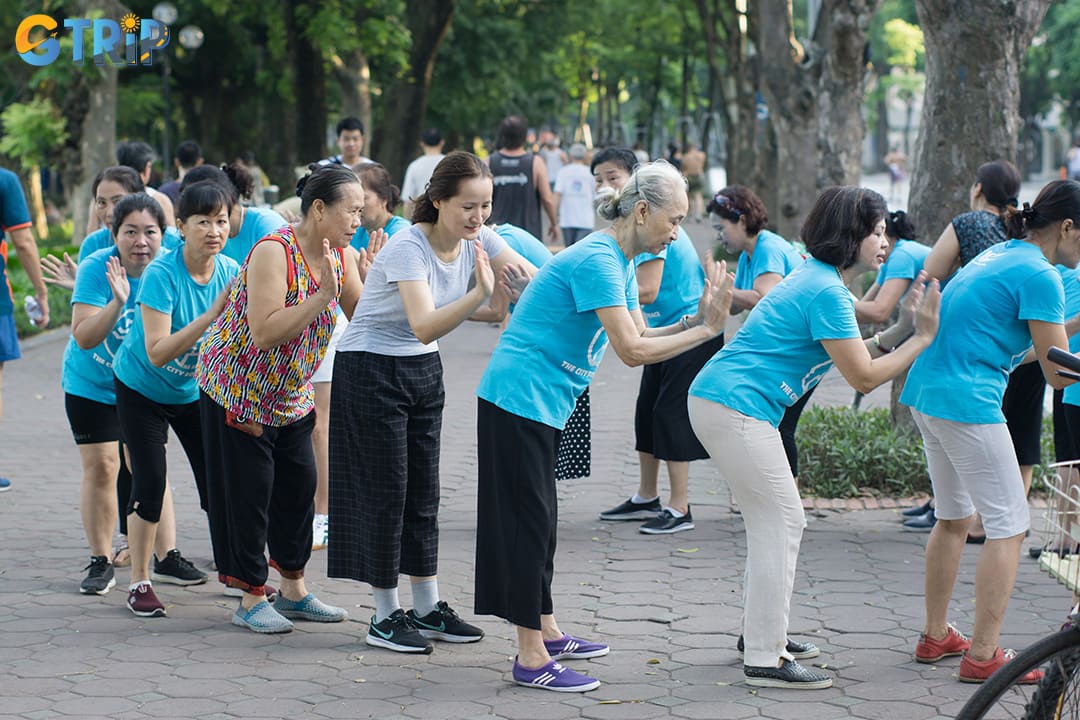
Experience Hanoi’s peaceful side at dawn with a walk around Hoan Kiem Lake, where locals gather for Tai Chi, dancing, and lakeside coffee as the city slowly awakens
25. Explore unique night tours in Hanoi
| No. | Activity / Tour Name | Location | Special features |
|---|---|---|---|
| 1 | “The Quintessence of Tonkin” Live Outdoor Show | Quoc Oai District | Large-scale outdoor stage combining dance, music, lighting, water effects, and 3D mapping to portray Northern Vietnamese culture. |
| 2 | Hoa Lo Prison Night Tour | Hoan Kiem District | Features 3 different themes, uses lighting, sound effects, and theatrical performances to recreate prisoners’ lives and escape stories. |
| 3 | Pedestrian Zones | Various Districts: Hoan Kiem, Ba Dinh, Hai Ba Trung, Tay Ho, Son Tay | Vibrant public spaces with cultural performances, street food, and community activities. |
| 4 | Thang Long Water Puppetry | Hang Trong, Hoan Kiem District | Traditional Vietnamese water puppetry performed on water with live folk music. |
| 5 | “Decoding the Imperial Citadel” Night Tour | Thang Long Imperial Citadel | Uses storytelling, historical reenactments, and lighting effects to explore royal history. |
| 6 | “Heart and Talent” Night Tour | Vietnam Museum of Literature | Interactive storytelling experience that introduces Vietnamese literature and notable authors. |
| 7 | Culinary Tour: Tong Duy Tan - Ta Hien - Dong Xuan Night Market | Hoan Kiem District | A food lovers’ tour through bustling street food areas and vibrant night markets. |
| 8 | Double-Decker City Bus Night Tour | Around the city | A panoramic view of Hanoi by night from an open-top bus, with guided commentary. |
| 9 | Dong Xuan Electric Car Route | Hoan Kiem District | Ideal for families and seniors, leisurely tour through the Old Quarter's cultural landmarks. |
| 10 | Cyclo Rides | Hoan Kiem District | Traditional rickshaw ride offering a slow-paced, nostalgic exploration of old Hanoi. |
| 11 | 9 PM Flag-Lowering Ceremony | Ho Chi Minh Mausoleum, Ba Dinh | Solemn nightly ceremony honoring President Ho Chi Minh. |
| 12 | Hanoi Book Street | Hoan Kiem District | Quiet, cozy spot in the city center combining books, coffee, and cultural activities. |
| 13 | “Legend of Youth” Art Program | Vietnamese Women’s Museum | New tour, inspiring live performance with storytelling, music, and emotional themes. |
| 14 | “Thang Long - Hanoi Night” Cycling Tour | Central Hanoi routes | New tour explores the city by night on a bicycle with historical narration. |
| 15 | “Essence of Confucianism” Night Tour | Temple of Literature | New tour recreates the spirit of ancient learning through lighting, traditional music, and immersive projections. |

Discover Hanoi mysterious Hanoi last night tours of cultural, historical and emotional cuisine
26. Visit Hanoi Aquarium
Hanoi Aquarium is a captivating destination for families, especially those with children, as well as anyone with a love for marine life. Located conveniently in the city center, this large-scale indoor aquarium features a vibrant underwater world with more than 3,000 marine specimens from around 300 species across the globe. You can marvel at the beauty of colorful tropical fish, graceful sea turtles, fascinating jellyfish, majestic sharks, and other exotic sea creatures.
One of the main highlights is the transparent underwater tunnel, which offers a 360-degree view of marine life and creates the thrilling sensation of walking beneath the ocean. The aquarium also hosts lively seal and dolphin shows, which are not only entertaining but also popular among both children and adults. In addition to its recreational appeal, Hanoi Aquarium serves an educational mission. Interactive exhibits raise awareness of marine life and ocean conservation, especially inspiring younger generations to care for the environment.

Explore Hanoi Aquarium’s vibrant underwater world with 3,000+ marine creatures, an ocean tunnel, and family-friendly dolphin and seal shows
27. Discover Quang Phu Cau Incense Village
Located about 30 kilometers from Hanoi, Quang Phu Cau Incense Village is one of Vietnam’s oldest traditional incense-making villages, with a history of over 100 years. The village is famous for its vibrant, photogenic scenes of thousands of incense sticks laid out to dry in circular bundles of red and pink, creating a stunning visual spectacle. You can witness the entire handcrafted process from mixing aromatic powders and shaping incense sticks to the final sun-drying stage. These scenes showcase the villagers’ craftsmanship and offer a unique backdrop that attracts photographers and culture lovers from around the world.
Beyond observation, you can take part in hands-on experiences, trying their hand at making incense and learning directly from local artisans. These activities provide insight into the cultural and spiritual role of incense in Vietnamese life, from ancestral worship to religious ceremonies. The village also sells high-quality incense products, allowing guests to bring home meaningful souvenirs while supporting the preservation of a time-honored tradition. A visit to Quang Phu Cau is both a sensory and cultural journey into Vietnam’s enduring heritage.
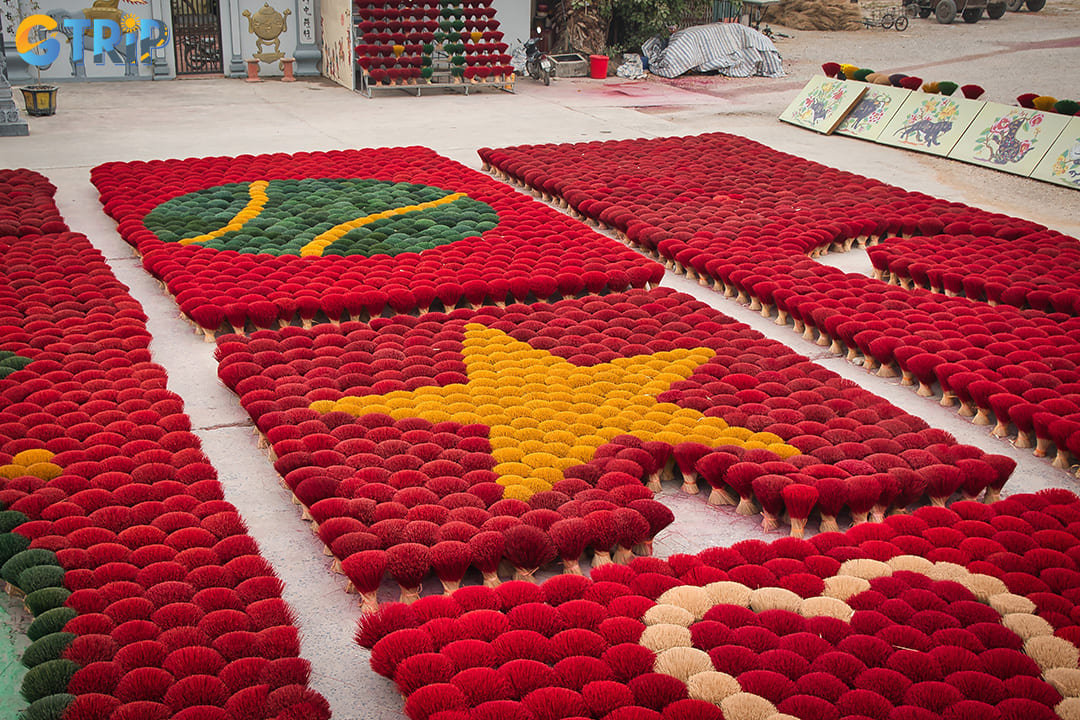
Discover the vivid beauty and 100-year-old craft of incense-making at Quang Phu Cau Village, where thousands of colorful incense sticks create iconic, photogenic scenes
28. Day trip to Ninh Binh
Located just about a 2-hour drive from Hanoi, Ninh Binh is a perfect destination for a day trip or short getaway, offering a refreshing escape from the bustle of the capital. Often referred to as “Halong Bay on land”, Ninh Binh captivates visitors with its dramatic limestone karsts, peaceful rivers, and mystical cave systems. The region’s lush green rice fields nestled between towering cliffs create postcard-perfect scenery that changes with the seasons.
A must-do experience in Ninh Binh is a boat ride through either the Trang An Scenic Landscape Complex or Tam Coc - Bich Dong. As you glide along calm waterways, you’ll pass through a network of natural caves, ancient pagodas, and serene valleys, making for a tranquil yet breathtaking journey. For nature and wildlife enthusiasts, the Cuc Phuong Ecotourism Area offers trails through primaeval forests, as well as visits to a primate rescue center that protects endangered species.
In addition to its natural charm, Ninh Binh is steeped in history. The region is home to Hoa Lu, Vietnam’s ancient capital during the Dinh and Early Le Dynasties. Here, you can explore centuries-old temples, royal ruins, and relics that reflect the country’s rich cultural heritage. Ninh Binh is an ideal blend of nature exploration and cultural discovery, making it one of the most rewarding short trips from Hanoi.

Just two hours from Hanoi, Ninh Binh enchants with limestone mountains, peaceful rivers, ancient temples, and scenic boat rides through Vietnam’s breathtaking countryside
How to get to Hanoi
Reaching Hanoi is straightforward with several transportation options available for travelers coming from international destinations or other parts of Vietnam. The city serves as a major transportation hub in Northern Vietnam, making it accessible via air, land, and rail routes. Below are the primary ways to reach this vibrant capital city.
Flights to Hanoi
Noi Bai International Airport (HAN) serves as Hanoi's main gateway, located approximately 30km northeast of the city center. The airport handles numerous international flights from major Asian hubs like Bangkok, Singapore, Seoul, and Hong Kong, as well as direct connections from European and Australian cities. Domestic flights connect Hanoi with other Vietnamese destinations, including Ho Chi Minh City, Da Nang, and Nha Trang. These routes typically operate multiple times daily with carriers like Vietnam Airlines, VietJet Air, and Bamboo Airways.
Buses to Hanoi
Extensive bus networks connect Hanoi to most major cities and towns throughout Vietnam with varying levels of comfort and price points. Overnight sleeper buses from popular destinations like Sapa (5-6 hours), Halong Bay (4 hours), and Ninh Binh (2 hours) offer economical options for budget travelers. Most long-distance buses arrive at one of Hanoi's three main bus stations: Giap Bat (south), My Dinh (west), or Gia Lam (east), with tickets easily purchased online or through local travel agencies.
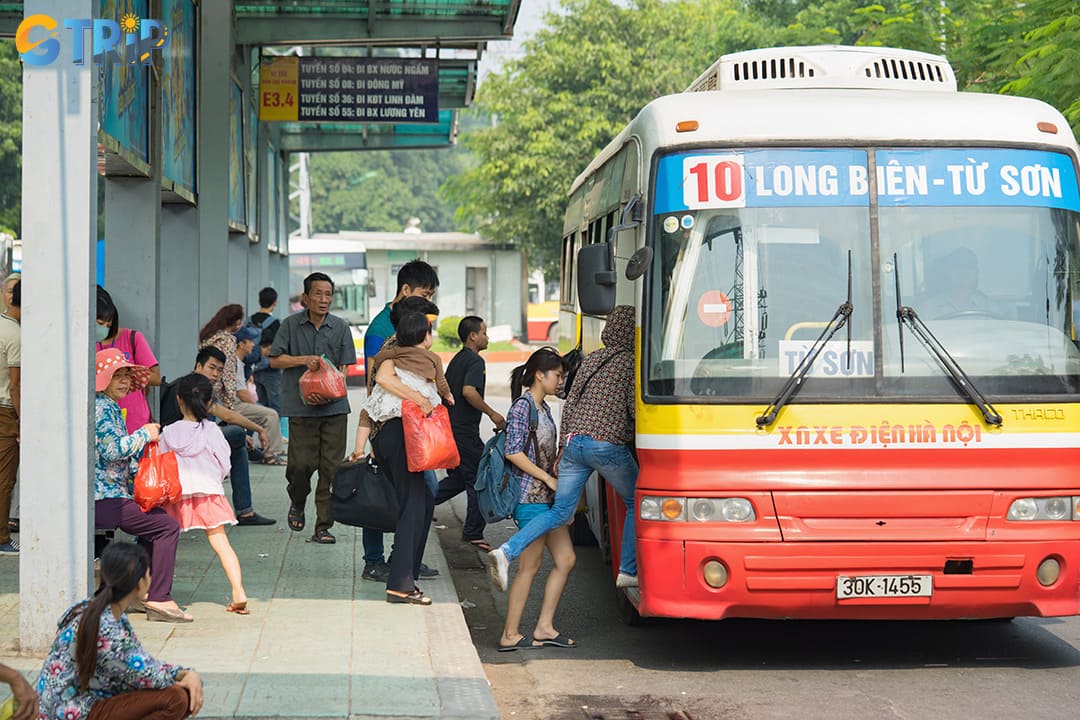
Hanoi is easily accessible via air, rail, and road, serving as Northern Vietnam’s main transportation hub for both domestic and international travelers
Trains to Hanoi
The rail system provides a comfortable and scenic alternative for reaching Hanoi from various destinations across Vietnam. Trains arrive at Hanoi Railway Station (Ga Hanoi) located near the city center, with regular services connecting to cities like Hue, Da Nang, and Ho Chi Minh City on the north-south Reunification Line. International travelers can also reach Hanoi by train from China via the Dong Dang border crossing, making the rail option particularly appealing for those seeking to experience Vietnam's countryside views during their journey.
How to get around to experience activities in Hanoi
Navigating Hanoi efficiently allows you to maximize your sightseeing time while experiencing the city's unique rhythm. The Vietnamese capital offers several transportation options that balance convenience, authenticity, and affordability providing a distinctive perspective on this vibrant city.
- Hanoi's taxis are abundant and relatively inexpensive compared to Western countries, making them a comfortable option for longer journeys. Most reputable companies use meters and provide air-conditioned vehicles, with Grab offering reliable fixed-price rides through their smartphone app.
- Metro service in Hanoi is relatively new, with the Cat Linh-Ha Dong line offering a modern alternative to surface transportation. The elevated train provides a traffic-free journey with stops near several attractions, though the limited network currently serves only specific parts of the city.
- Cyclo rides offer one of the most atmospheric ways to experience Hanoi's historic districts at a leisurely pace. These three-wheeled bicycle rickshaws allow you to sit back and absorb the sights while your driver navigates narrow streets that larger vehicles can't access.
- Xe om (Motorbike taxi) services provide the quintessential Hanoi travel experience, weaving through traffic with local expertise. Drivers can be found on street corners wearing distinctive helmets, though negotiating prices beforehand is essential as they rarely use meters.
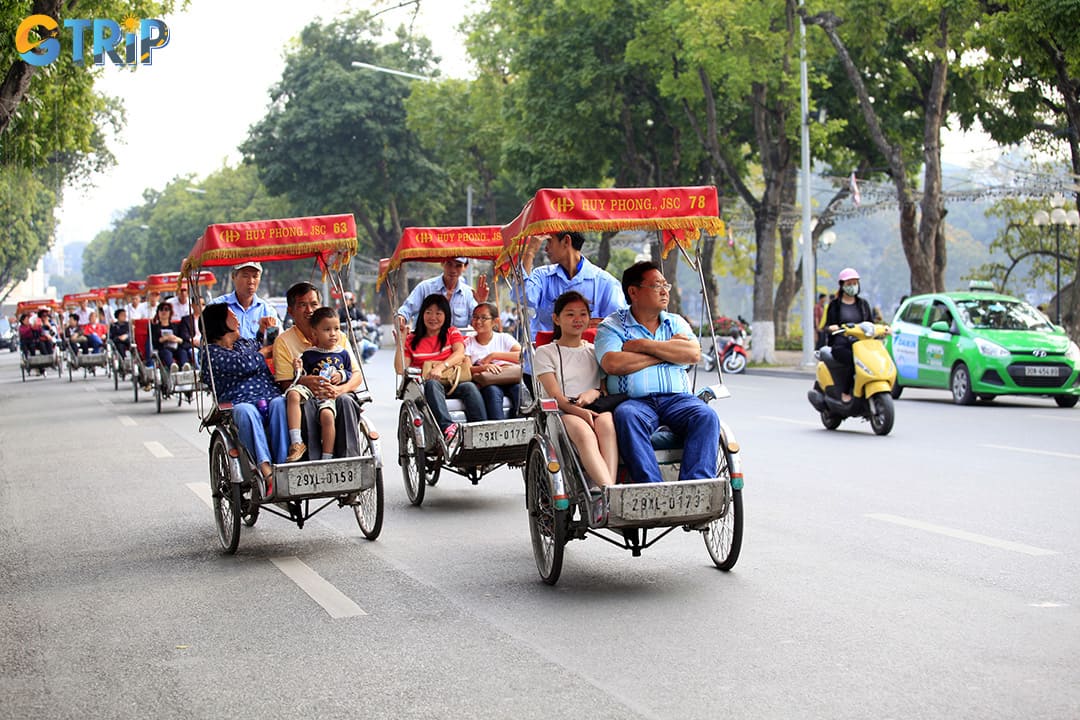
Getting around Hanoi is easy and affordable with taxis, motorbike taxis, metro lines, and traditional cyclos offering diverse ways to explore the city’s vibrant charm
Transportation tips for visitors
- Safety first: Always wear helmets when using motorbike services and confirm the price before starting your journey
- Peak-hour awareness: Avoid rush-hour travel between 7-9am and 5-7pm when possible
- Apps over street hails: Use Grab or reputable taxi companies to ensure fair pricing
- Small change: Keep small denominations handy for exact payment with drivers
Exploring Hanoi is like unraveling a vibrant tapestry of history, culture, and tantalizing flavors. This energetic city offers a unique blend of age-old traditions and modern attractions that promise every visitor an unforgettable experience. Wandering through bustling street markets, indulging in delicious local cuisine, or marveling at historic temples, Hanoi never fails to captivate and delight its guests. By immersing yourself in these diverse activities, you've gained a deeper appreciation for the city's rich heritage while creating memories that will last a lifetime.
Your discovery journey with GTrip doesn't have to end here, there are always more paths to uncover and stories waiting to be told. As you plan your next adventure-or perhaps reflect on this one-remember that each experience adds another layer to your travel tale. With countless destinations still calling out from the horizon, may your wanderlust continue unimpeded wherever it takes you next!

